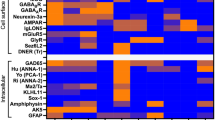Abstract
Borna Disease Virus (BDV) is suspected to infect humans and to be associated with psychiatric disorders. To this date, BDV-reactive antibodies provide the only reliable markers to diagnose human BDV infection. Their diagnostic value, however, was recently questioned by the observation that these antibodies recognize BDV antigen with only low avidity, a typical feature of cross-reacting antibodies. This raised the possibility that the human BDV-reactive antibodies were triggered by other pathogens than BDV. The recent establishment of a peptide array-based screening test allowed the further characterization of these antibodies. It revealed the presence of small amounts of BDV-reactive antibodies in crude human sera that specifically recognized various epitopes of three major BDV proteins. Most importantly, the purified epitope-specific antibodies were shown to bind to BDV antigen with high avidity when assayed by conventional immunofluorescence assay (IFA) or by Western blot. These results are compatible with the view that the presence of BDV-reactive antibodies in human sera reflects an infection with BDV, although the poor affinity maturation remains unexplained. Furthermore, it demonstrates that peptide array-based screening tests are a reliable system for identifying monospecific antibodiesfrom human polyclonal sera with high specificity and sensitivity.
Similar content being viewed by others
References
Reineke, U., Ivascu, C., Schlief, M. et al., Identification of distinct antibody epitopes and mimotopes from a peptide array of 5520 randomly generated sequences, J. Immunol. Methods, 267 (2002) 37-51.
Frank, R., High-density synthetic peptide microarrays: Emerging tools for functional genomics and proteomics, Comb. Chem. High Throughput Screen, 5 (2002) 429-440.
Reineke, U., Volkmer-Engert, R. and Schneider-Mergener, J.,Applications of peptide arrays prepared by the SPOT-technology, Curr.Opin. Biotechnol., 12 (2001) 59-64.
Valle, M., Munoz, M., Kremer, L. et al., Selection of antibody probes to correlate protein sequence domains with their structural distribution, Protein Sci., 8 (1999) 883-889.
Billich, C., Sauder, C., Frank. R. et al., High-avidity human serum antibodies recognizing linear epitopes of Borna disease virus proteins, Biol. Psychiatry, 51 (2002) 979-987.
Billich, C., Charakterisierung von Borna Disease Virus-spezifischen Antikörpern in Human und Tierseren. Abteilung Virologie, Institut für Medizinische Mikrobiologie und Hygiene, Albert-Ludwigs-Universität Freiburg, 2002.
Staeheli. P., Sauder, C., Hausmann, J., Ehrensperger, F. and Schwemmle, M., Epidemiology of Borna disease virus, J.Gen.Virol., 81 (2000) 2123-2135.
Schneemann, A., Schneider, P. A., Lamb, R. A. and Lipkin, W. I., The remarkable coding strategy of Borna disease virus: A new member of the nonsegmented negative strand RNA viruses, Virology, 210 (1995) 1-8.
Tomonaga, K., Kobayashi, T., Lee, B. J., Watanabe, M., Kamitani, W. and Ikuta, K., Identification of alternative splicing and negative splicing activity of a nonsegmented negative-strand RNA virus, Borna disease virus. Proc. Natl. Acad. Sci. USA, 97 (2000) 12788-12793.
Ludwig, H., Bode, L. and Gosztonyi, G., Borna disease: A persistent disease of the central nervous system, Progr.Medical Virol., 35 (1988) 107-151.
Schneider, P., Hatalski, C. G., Lewis, A. J. and Lipkin, W. I., Biochemical and functional analysis of the Borna disease virus glycoprotein, J. Virol., 71 (1997) 331-336.
Wehner, T., Ruppert, A., Herden, C., Frese, K., Becht, H. and Richt, J. A., Detection of a novel Borna disease virus encoded 10 kilodalton protein in infected cells and tissues, J. Gen. Virol., 8 (1997) 2459-2466.
Walker, M. P., Jordan, I., Briese, T., Fischer, N. and Lipkin, W. I., Expression and characterization of the Borna disease virus polymerase, J. Virol., 74 (2000) 4425-4428.
Schwemmle, M., Borna disease virus infection in psychiatric patients: Are we on the right track? Lancet Infect. Dis., 1 (2001) 46-52.
Carbone, K. M., Borna disease virus and human disease, Clin. Microbiol. Rev., 14 (2001) 513-527.
Hornig, M., Briese, T. and Lipkin, W. I., Bornavirus tropism and targeted pathogenesis: Virus-host interactions in a neurodevelopmental model, Adv. Virus Res., 56 (2001) 557-582.
Richt, J. A. and Rott, R., Borna disease virus: A mystery as an emerging zoonotic pathogen, Vet. J., 161 (2001) 24-40.
Rott, R., Herzog, S., Fleischer, B. et al., Detection of serum antibodies to Borna disease virus in patients with psychiatric disorders, Science, 228 (1985) 755-756.
Jordan, I., Lipkin, W. I., Borna disease virus, Rev. Med. Virol, 11 (2001) 37-57.
Lieb, K. and Staeheli, P., Borna disease virus-Does it infect humans and cause psychiatric disorders? J. Clin. Virol., 21 (2001) 119-127.
Lieb, K., Hallensleben, W., Czygan, M., Stitz, L. and Staeheli, P., No Borna disease virus-specific RNA detected in blood from psychiatric patients in different regions of Germany. The Bornavirus Study Group, Lancet, 350 (1997) 1002.
Schwemmle, M., Jehle, C., Formella, S. and Staeheli, P., Sequence similarities between human bornavirus isolates and laboratory strains question human origin, Lancet, 354 (1999) 1973-1974.
Formella, S., Jehle, C., Sauder, C., Staeheli, P. and Schwemmle, M., Sequence variability of Borna disease virus: Resistance to superinfection may contribute to high genome stability in persistently infected cells, J. Virol., 74 (2000) 7878-7883.
Allmang, U., Hofer, M., Herzog, S., Bechter, K. and Staeheli, P., Low avidity of human serum antibodies for Borna disease virus antigens questions their diagnostic value, Mol. Psychiatry, 6 (2001) 329-333.
Gutierrez, J. and Maroto, C., Are IgG antibody avidity assays useful in the diagnosis of infectious diseases? A review, Microbios, 87 (1996) 113-121.
Lehtonen, O. P. and Meurman, O. H., Avidity of IgG antibodies against mumps, parainfluenza 2 and Newcastle disease viruses after mumps infection, J. Virol. Methods, 14 (1986) 1-7.
Schupbach, J., Baumgartner, A. and Tomasik, Z., HTLV-1 in Switzerland: Low prevalence of specific antibodies in HIV risk groups, high prevalence of cross-reactive antibodies in normal blood donors, Int. J. Cancer, 42 (1988) 857-862.
Frank, R. and Overwin, H., SPOT synthesis. Epitope analysis with arrays of synthetic peptides prepared on cellulose membranes, Methods Mol. Biol., 66 (1996) 149-169.
Author information
Authors and Affiliations
Rights and permissions
About this article
Cite this article
Schwemmle, M., Billich, C. The use of peptide arrays for the characterization of monospecific antibody repertoires from polyclonal sera of psychiatric patients suspected of infection by Borna Disease Virus. Mol Divers 8, 247–250 (2004). https://doi.org/10.1023/B:MODI.0000036244.57859.76
Issue Date:
DOI: https://doi.org/10.1023/B:MODI.0000036244.57859.76




